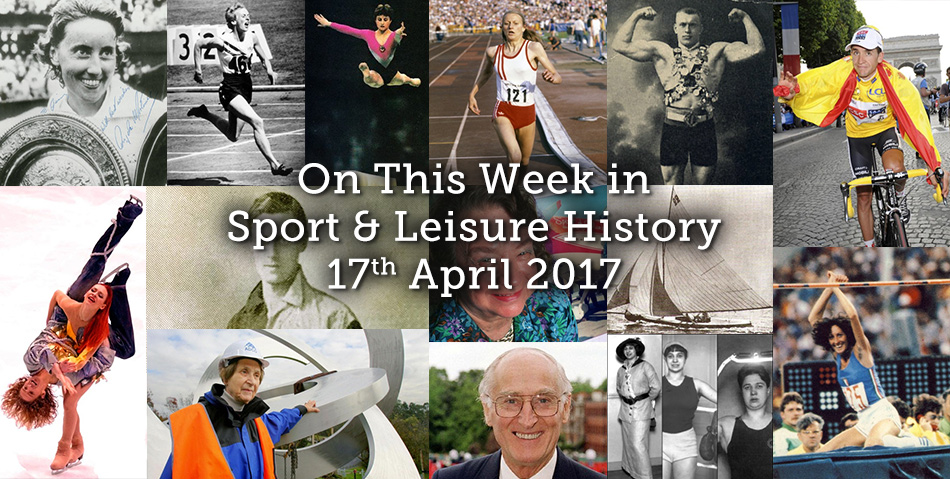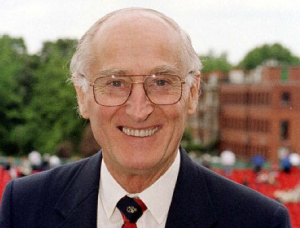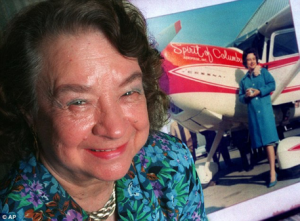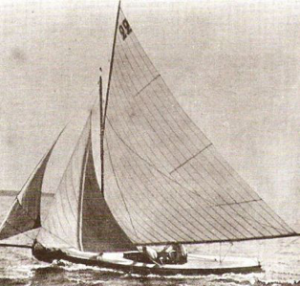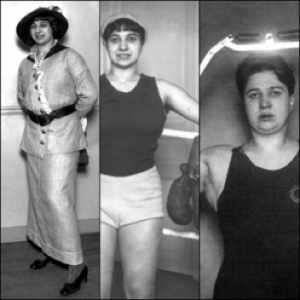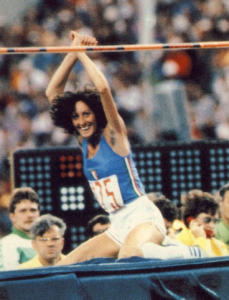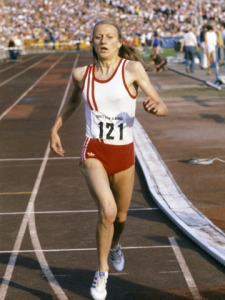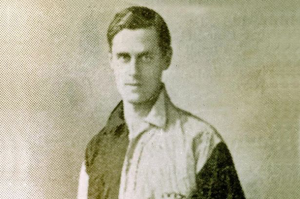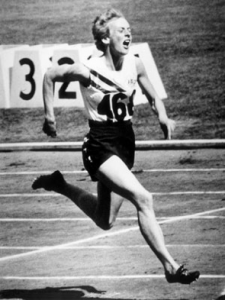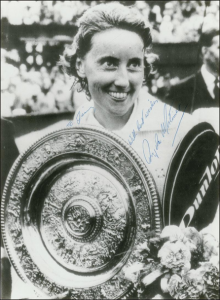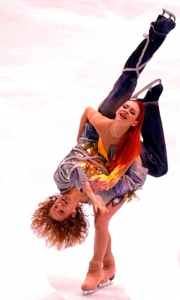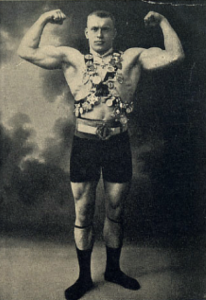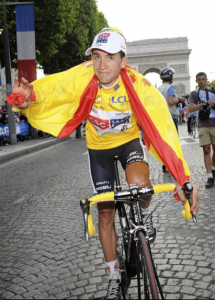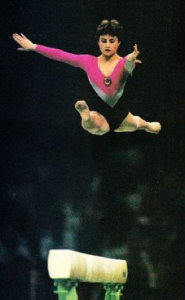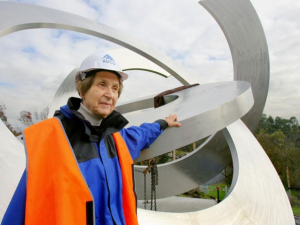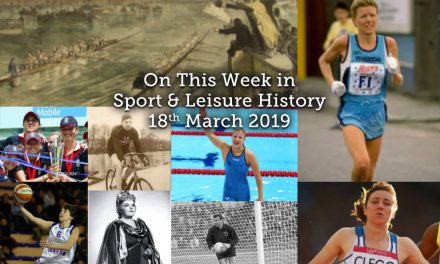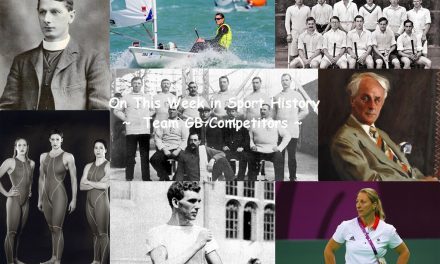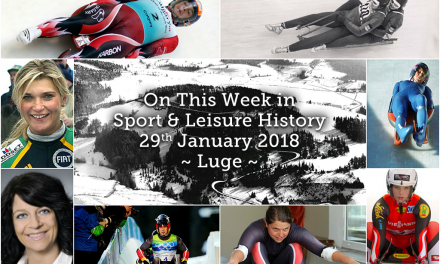17th – The Greek tennis player Demetrios Petrokokkinos was born today in 1878. He competed at the 1896 Olympics, he was defeated in the first round of the singles tournament by fellow Greek Evangelos Rallis. This put him in a six-way tie for eighth (last) place among the thirteen man field. In the doubles tournament, Petrokokkinos again faced Rallis in the first round. This time, Petrokokkinos and his partner Dionysios Kasdaglis of Egypt defeated Rallis and his partner Konstantinos Paspatis. Petrokokkinos and Kasdaglis faced Edwin Flack of Australia and George S. Robertson of Great Britain in the semi-finals, again winning the match to advance to the final. There, they met Irishman John Pius Boland and German Friedrich Traun, to whom they lost to place second. Carl Heinrich Goßler, German Olympic rower was born in 1885. He competed in the 1900 Olympics where he was the coxswain of the German boat Germania Ruder Club, Hamburg, which won the gold medal in the coxed fours final B. He was killed in action during World War I. Former British tennis player, TV commentator and author, John Barrett, was born on this day in 1931. His father Alfred had the rare distinction of having played both for Leicester Tigers RFC as a wing three-quarter and for Leicester Fosse FC (the former Leicester City) as a wing half. John went on to compete at Wimbledon for eighteen years from 1951, reaching the third round of the singles on four occasions and the quarter-finals of the mixed doubles three times. At his peak he was ranked as his country’s fifth best singles player. His doubles successes included the capture of the 1953 National Covered Court title with Don Black of Rhodesia and the 1956 Asian Doubles with Roger Becker. In 1956 he became a Davis Cup player and was appointed captain of the British Davis Cup team for the years 1959-1962. Three years later he established and ran the LTA Training Squad, known as “The Barrett Boys” which set new standards of fitness in British tennis between 1965 and 1968. His broadcasting career with BBC Television began in 1971 and he followed Dan Maskell as the BBC’s ‘Voice of Wimbledon’ until his retirement following Wimbledon in 2006. He also commentated for Channel 9, Australia (1980-1986) and for Channel Seven, Australia (1987 – 2007) and at various times for HBO, ESPN, and the USA Networks in America, CTV in Canada and both ATV and TVB in Hong Kong. In 2007 he was awarded the MBE for Services to Sports Broadcasting. For fourteen years (1997-2001) he served as President of The Dan Maskell Trust, a charitable organisation established in 1997 to help people with disabilities to play tennis. A member of the International Lawn Tennis Club of Great Britain since 1953, he served as Chairman from 1983-1994, as President from 2004-2008 and is currently a Vice-President. A member of the All England Lawn Tennis and Croquet Club since 1955 and currently a Vice-President, he served for twelve years on the Club Committee and the Committee of Management of The Championships, during which time he started to compile a complete database of every result that has ever occurred at Wimbledon, in all events. This mammoth task took some 20 years to complete and can now be accessed on the Club’s web site. In April 1967 he married the former French, Australian and Wimbledon champion Angela Mortimer and they have a son, a daughter and four grandchildren. In 2014 Barrett was inducted into the International Tennis Hall of Fame. On this day in 1939 Joe Louis knocks out Jack Rope in the first round to win the heavyweight boxing title. Yachtswoman Clare Francis was born in 1946. In 1976 she made the fastest crossing of the Atlantic by a woman. Competing in the Observer single-handed race, she made the crossing in 29 days. Finnish middle-distance athlete Pekka Antero Vasala was born in 1948. He won an Olympic gold in the 1972 Games in Munich. In the 1968 Olympics in Mexico City he failed to advance from the first round of heats in the 1500m. His later success is partly attributed to his legendary hill training of which he said “[it] is suicidal for other runners to copy my hill sessions without adequate background“. In Munich he won the 1500m in a time of 3:36.3secs, ahead of the legendary Kip Keino and Rod Dixon. This marked a memorable day for Finnish athletics because his countryman Lasse Virén won the 5000m earlier in the day, in addition to winning the 10,000m in world record time earlier in the games. With a medal in every track event from 1500 to 10,000m, three gold and a bronze (Tapio Kantanen in the 3000m steeplechase) Finnish athletes achieved a level of success not seen since the era of the “Flying Finns” (1912–1936).His nephew, Samuli Vasala, also an athlete, won the 2003 Nordic Cross Country Championships. Vasala is the son-in-law of Martti Matilainen. The Peak District became the United Kingdom’s first National Park on this day in 1951. Jerrie Mock, a relatively untested pilot, accomplished on this day in 1964 what Amelia Earhart could not, becoming the first woman to fly solo around the world. When she took off on March 19, 1964, from Columbus, Ohio, Mrs. Mock was a 38-year-old housewife and recreational pilot who had logged a meagre 750 hours of flight time. She returned there on April 17 — 29 days, 11 hours and 59 minutes later — after a 23,000-mile journey over the Atlantic, the Mediterranean, the Red Sea, the Gulf of Oman, the Arabian Sea and the Pacific, with stops in the Azores, Casablanca, Cairo, Karachi, Calcutta, Bangkok and Honolulu, among other places. She navigated 1,300 miles over the Pacific from Guam to tiny Wake Island, three miles in diameter, without the benefit of ground signals. Between Bangkok and Manila, she flew over embattled Vietnam. “Somewhere not far away a war was being fought,” she wrote later, “but from the sky above, all looked peaceful.” Mrs. Mock and her husband, Russell, were half-owners of the plane, an 11-year-old single-engine Cessna 180 named the Spirit of Columbus (evoking the Spirit of St. Louis, the plane Charles Lindbergh flew in becoming the first to cross the Atlantic solo 37 years earlier).The Mocks’ plane had been modified for the journey. Three of its four seats had been removed and fuel tanks were installed in their place. That summer, Flying magazine asked Mrs. Mock why she had undertaken such a treacherous journey alone. “It was about time a woman did it,” she said. Mrs. Mock’s feat has largely been overlooked in popular history; she is not an inductee of the National Aviation Hall of Fame, in Dayton, Ohio. But she was celebrated at the time. The Columbus Evening Dispatch, her home-town paper and one of the trip’s sponsors, splashed her return across the front page with the headline “Jerrie Does It; Sets Global Air Mark.” On this day in 1966 the 100th international football match between Netherlands and Belgium took place in Rotterdam. The Netherland were the 3-1 winners. Neil Thomas became the first Briton to win a medal in the World Gymnastics Championships when he took silver in the floor exercises of the tournament in 1993, held at the National Exhibition Centre in Birmingham. On this day in 2011 Emmanuel Matai set a new course record when winning the London Marathon at his fourth attempt, his winning time being 2:04:40. Today in 2015 James Anderson became the highest wicket-taking bowler in England’s test cricket history.
- John Barrett
- Jerrie Mock
18th – On this day in 1809 the first running of the 2000 Guineas took place at Newmarket. Linton Hope (born Hopps), a British sailor who was born on this day 1863, in Macclesfield, Cheshire represented Great Britain at the 1900 Olympics in Meulan, France. With Lorne Currie as helmsman and fellow crewmembers John Gretton and Algernon Maudslay, Hope took first places in both the 0.5 to 1 ton class and the Open class. Hope designed a variety of yachts, as well as the Fairy One Design for the North of Ireland Yacht Club, international canoes and Thames Raters. Both Olympic races were won using the yacht Scotia designed by Hope. He was appointed naval architect to the King of the Belgians. In 1915 Hope designed the AD Flying Boat for the British Admiralty’s Air Department and his hull designs were used by a number of British flying boats in the 1920s including the Phoenix P.5 Cork and Fairey Titania, largest flying boat in the world at the time. Violette Morris, French athlete who won two golds and a silver at the Women’s World Games in 1921–1922 was born today in 1893. She served in World War I as a military nurse during the Battle of the Somme and a courier during the Battle of Verdun. Morris was a gifted athlete, becoming the first French woman to excel at shot put and discus, and playing on two separate women’s football teams. She played for Fémina Sports from 1917 until 1919, and for Olympique de Paris from 1920 to 1926. Both teams were based in Paris. She also played on the French women’s national team. In addition to her football career, she was an active participant in many other sports. She was selected for the French national water polo team even though there was no women’s team at the time. She was an avid boxer, often fighting against, and defeating men. She became French national champion in 1923. Among the other sports she participated in were road bicycle racing, motorcycle racing, car racing, airplane racing, horseback riding, tennis, archery, diving, swimming, weightlifting, and Greco-Roman wrestling. Her most brilliant athletic years were considered to be from 1921 to 1924, when her slogan was “Ce qu’un homme fait, Violette peut le faire!” (Anything a man can do Violette can do!). She later won the 1927 Bol d’Or 24 Hours car race at the wheel of a BNC. She was refused license renewal by the Fédération française sportive féminine (FFSF – French Women’s Athletic Federation) amid complaints of her bisexual lifestyle and was therefore barred from participating in the 1928 Olympics. The agency cited her lack of morals, especially in light of the fact that one of her lovers, Raoul Paoli, made public her bisexuality. Paoli had recently left Morris after she had initially decided to undergo an elective mastectomy in order to fit into racing cars more easily. After 1928, Morris settled into owning a car parts store in Paris, and, along with her employees, building racing cars. At the end of December 1935, Morris was recruited by the Sicherheitsdienst (Security Service), a wing of the infamous SS of Nazi Germany. She was invited, with honour, to attend the 1936 Olympics in Berlin at the personal behest of Adolf Hitler. She gave Germany partial plans of the Maginot Line, detailed plans of strategic points within the city of Paris, and schematics of the French army’s main tank, the Somua S35. Her plans were integral to the German invasion of Paris in 1940. She benefited from the German occupation, often colluding with the local mob. She lived through the German occupation in a houseboat on the River Seine. One of her main responsibilities during the war was to foil the operation of the Special Operations Executive, the British-run organisation that helped the resistance. For these activities, Morris was sentenced to death in absentia and was killed along a country road by members of a French resistance group on 26 April 1944, at the age of 51, while out driving with friends who were also collaborators. Two other passengers were little children. They too were killed. Her body, riddled with bullets, was never claimed, and was buried in a communal grave. In 1903 Bury registered the biggest winning margin in FA Cup final history by beating Derby County 6-0 at Crystal Palace. Doug Insole, former English cricketer was born in 1926. He played for Cambridge University, Essex and in nine Test matches for England, five of them on the 1956-57 tour of South Africa, where he was vice-captain to Peter May. After retiring from playing, he was prominent in cricket administration, and served as chairman of the England selectors and as President of the MCC. Racing driver Jochen Rindt was born in 1942. German-born Rindt was brought up in Austria. In 1970 he became the first and only man to be declared world-champion posthumously. West Indian fast bowler Malcolm Marshall was born today in 1958. He is the second West Indian bowler, after Lance Gibbs, to take 300 Test wickets. On this day in 1966 Bill Russell agreed to become head coach of the Boston Celtics NBA team, which made Russell the first African American head coach in NBA history. He commented to journalists: “I wasn’t offered the job because I am a Negro, I was offered it because Red figured I could do it. Born today in 1990, Anna van der Breggen, Dutch racing cyclist. While participating in the Team Time Trial at the 2014 Road World Championships in Ponferrada, Spain, van der Breggen broke her pelvis in a crash sustained by her Rabo Liv team. However, she recovered to win her first race of 2015, the Omloop Het Nieuwsblad. In 2015, she won a bronze medal in the Road Race at the inaugural European Games, and was awarded won the Gerrit Schulte Trophy for the best Dutch of cyclist of the year. She won gold in the women’s road race at the 2016 Rio Olympics. Ioana Ducu, Romanian tennis player, was born on this day in 1996. She has won one doubles title on the ITF tour in her career. On 9 September 2013, she reached her best singles ranking of world number 830. On 3 November 2014, she peaked at world number 736 in the doubles rankings. In June 2014, together with fellow Romanian Ioana Loredana Roșca, Ducu won the girls’ doubles tournament at the French Open, defeating CiCi Bellis and Markéta Vondroušová in three sets in the final.
- Violette Morris
19th – Sydney Barnes, English professional cricketer who is generally regarded as one of the greatest ever bowlers, was born in 1873. He was right-handed and bowled at a pace that varied from medium to fast-medium with the ability to make the ball both swing and break from off or leg. Barnes was unusual in that, despite a very long career as a top-class player, he spent little more than two seasons in first-class cricket, representing Warwickshire and Lancashire. Instead, he preferred league and minor counties cricket for mostly professional reasons. He played for several clubs in the Lancashire, North Staffordshire, Bradford and Central Lancashire leagues between 1895 and 1934. In addition, he had two phases playing for Staffordshire in the Minor Counties Championship. In Test cricket, Barnes played for England in 27 matches from 1901 to 1914, taking 189 wickets at 16.43, one of the lowest Test bowling averages ever achieved. In 1911–12, he helped England to win the Ashes when he took 34 wickets in the series against Australia. In 1913–14, his final Test series, he took a world-series record 49 wickets against South Africa. In 1963, Barnes was named by Wisden Cricketers’ Almanack in its hundredth edition as one of its “Six Giants of the Wisden Century”. In 2008, he had the highest rating among bowlers in the ICC Best-Ever Test Championship Ratings and, in 2009, he was inducted into the ICC Cricket Hall of Fame. The first Boston Marathon was held in 1897 and won by John J McDermott of New York in 2:55:10. Held every April on Patriot’s Day, it has been run every year since its inauguration and is the world’s oldest annual race of its kind. Sara Simeoni, Italian high jumper, who won gold at the 1980 Olympics and twice set a world record in the women’s high jump, was born today in 1953. She soon took up athletics, specialising in the high jump. Her first international result was at the 1971 European Championships in Helsinki, where she ended in 9th with a 1.78m jump. Her first international success was at the 1976 in Montreal, where she won silver, with a personal best of 1.91m, and was beaten only by Rosemarie Ackermann’s 1.93m leap. In August 1978, she set the new world record with 2.01m in Brescia. Later in the same month she equalled it at Prague while winning the European title. In 1980, Simeoni set a new Olympic record of 1.97m, when winning gold in Moscow. Simeoni was the only woman athlete not from a Communist country to win an athletics gold medal in Moscow. At 1984 Olympics, Simeoni carried the Italian flag at the opening ceremony, here, she cemented her reputation as one of the greatest female high jumpers ever, in a thrilling duel with German Ulrike Meyfarth. Simeoni managed to reach 2 meters for the first time since 1978. The ageing Meyfarth, however, replied with a notable 2.02m jump, and Simeoni won a silver medal. Simeoni’s other titles include two bronze medals at the European Championships and 25 national titles. Her jump of 2.01m was the Italian record for women for 29 years. On 8 June 2007, Antonietta Di Martino jumped 2.02m, establishing the new Italian record for women. Sara Simeoni is widely considered one of the best Italian female athletes ever. She is married to her coach Erminio Azzaro. Their son Roberto Azzaro is also a high jumper. Test cricket umpire Harold “Dickie” Bird was born in 1933. A former player with Yorkshire and Leicestershire, he made his name as one of the best-known and best-loved umpires. The former England footballer Trevor Francis was born in 1954. He joined Birmingham City as a 16-year-old and subsequently transferred to Nottingham Forest, in 1979, becoming Britain’s first £1 million footballer. He enjoyed a spell in Italy before returning to Britain and eventually going into management at Sheffield Wednesday. Bobby Charlton played the first of his 106 games for England against Scotland at Hampden Park in 1958. He also scored the first of his record 149 goals in the 4-0 win. On this day in 1966, Roberta Louise “Bobbi” Gibb became the first woman to run the entire Boston Marathon. She is recognized by the Boston Athletic Association as the pre-sanctioned era women’s winner in 1966, 1967, and 1968. At the Boston Marathon, the pre-sanctioned era comprised the years from 1966 through 1971, when women ran and finished the race unofficially. In 1996 the BAA retroactively recognized as champions the unofficial women’s leaders of 1966–71. Gibb’s run in 1966 challenged prevalent prejudices and misconceptions about women’s athletic capabilities. Today in 1982, Rosie Ruiz, the Cuban American runner who was declared the winner in the female category for the 84th Boston Marathon in 1980, was arrested for forgery. She was charged with embezzling $60,000 from the real estate company which she worked for. Not a stranger to controversy, she was stripped of her 1980 marathon title eight days after the race when it was discovered that she had not run the entire course. She is believed to have jumped onto the course about a half-mile before the finish. Today in 1987 The Simpsons first appeared, as a series of shorts, on The Tracey Ullman Show, first starting with Good Night. At St Mellion, Cornwall, in 1991, Ian Woosnam missed the cut in the Benson and Hedges International after two opening rounds of 82; a week earlier he had won the US Masters – in the words of the immortal Greavsie, “Funny ‘old game, golf!” The Norwegian marathon runner and former world record holder, Grete Waitz née Andersen, died today in 2011. In 1979, she became the first woman in history to run the marathon in under two and a half hours. She won nine New York City Marathons between 1978 and 1988, more than any other runner in history. She won a silver at the 1984 Olympic Games in Los Angeles and gold at the 1983 World Championships in Helsinki. Her other marathon victories included winning the London Marathon in 1983 and 1986. She was also a five-time winner of the World Cross Country Championships.
- Sara Simeoni
- Grete Waitz
20th – Born today in 1860 was French trap shooter Justinien Clary. He competed in the late 19th century and early 20th century, participating in Shooting at the 1900 Summer Olympics in Paris, winning bronze in the trap shooting competition. Fellow Frenchmen Roger de Barbarin and Rene Guyot won gold and silver respectively. Clary was born and died in Paris. The world’s first motor racing using mechanical power took place at Paris in 1887. Count Jules Philippe de Dion won the 19.3mile (31km) race at an average speed of 37mph (59.5 km/hr) in his De Dion steam quadricycle. Harold Godfrey Bache, English cricketer who played 20 first-class matches between 1907 and 1910, 17 of them for Worcestershire, was born in 1889. Bache was also a fine footballer, playing for Corinthian F.C. and West Bromwich Albion and winning an England cap. Bache was educated at King Edward VI School, Birmingham, and Caius College, Cambridge. He made his first-class debut for Worcestershire against Surrey at Worcester late in the 1907 season, scoring 9 in his only innings and holding three catches. The following season he played twice for the county, but he made nine appearances in 1909 and eight in 1910. Mostly he played for Worcestershire but he turned out three times for Cambridge University, but was never awarded a Blue. His top score of 36 was made against Middlesex at Lord’s in 1910. Later in the same season against the same opposition, but this time at Worcester, he took two of his three career wickets: those of Patsy Hendren and Jack Hearne. His other wicket was that of Sussex’s Robert Relf in 1909. Bache played for the elite Corinthian FC 43 times and scored 95 goals. The Corinthians were the first icons of world football and provided Bache the perfect platform to showcase his talents. He scored 7 in the 13-0 victory over Ipswich on New Years Eve in 1910 for example. He excelled whilst on the clubs famous tours and in 1911, took little mercy on his Canadian and American hosts, netting 34 goals in just 18 matches. Bache joined the Lancashire Fusiliers and reached the rank of Second Lieutenant. He was killed in action at Ypres, Belgium at the age of just 26. Having no known grave, he is commemorated on the Menin Gate Memorial. On this day in 1920 the 7th modern Olympic Games were opened in Antwerp, Belgium. Phill Hill, the first North American to win the world motor-racing drivers’ title, was born in 1927. He won the title in 1961. In 1931 the British House of Commons agreed that sport could be played on a Sunday. The former Great Britain rugby league coach Maurice Bamford was born in 1936. He had unsuccessful periods at Huddersfield, Wigan and Batley before his talent as a motivator emerged at Halifax. He was snapped up by Leeds and then appointed coach to the national side. Elizabeth “Betty” Cuthbert, Australian athlete, and a four times Olympic champion was born in 1938. During her career, she set world records for 60m, 100yds, 200m, 220yds and 440yds. She went to Ermington Public School which inspired and supported her to go in to the Olympics. Cuthbert also a member of the Australian relay teams winning in the 4×100m, 4×110yds, 4×200m and 4×220yds. At the age of 18, prior to the 1956 Olympics in Melbourne, she set a World Record in the 200m, making her one of the favourites for gold in that event. She reached the finals of the 100m, setting an Olympic record of 11.4sec in her heat (also her PB), while the Australian World Record holder Shirley Strickland de la Hunty was eliminated. She won the final which made her the big favourite for the 200m title. She lived up to the expectations, and became the Australian “Golden Girl”. A third gold medal for Cuthbert came when she ran the final leg on in the 4x100m final, which the Australian team won in a new World Record. During 1958 Cuthbert set world records for 100 and 220yds but was beaten in both events by arch-rival and double-Olympic bronze medallist Marlene Mathews at the Australian Championships. Later in the year, at the Empire Games at Cardiff, she could only place fourth in the 100yds and second in the 220yds, again behind Mathews. In the lead-up to the 1960 Olympics Cuthbert set a world 220yds and 200m record of 23.2sec in winning the Australian championships. At the Rome Games, she suffered from injury and was eliminated from the heats of the 100m and subsequently, she retired from the sport of track & field. Her retirement did not last long, though, for she returned at the 1962 Commonwealth Games in Perth, helping Australia to gold in the sprint relay. Afterwards, she concentrated on the 400m, and she competed in that event in the 1964 Olympics, in Tokyo, when it was on the Olympic programme for women for the first time. Though not impressive in the heats, Cuthbert won the title for her fourth Olympic gold medal, beating Ann Packer of Great Britain. She is the only Olympian, male or female, to have won a gold medal in all sprint events: 100m, 200m and 400m. She subsequently verified her retirement for good after Tokyo. Cuthbert was one of the bearers of the Olympic Torch at the Opening Ceremony of the 2000 Olympics in Sydney, sitting in a wheelchair and accompanied by Raelene Boyle, she carried the Olympic Torch at the stadium, as one of the runners for the final segment, before the lighting of the Olympic Flame by Cathy Freeman. On this day in 1949 jockey Bill Shoemaker won his first race, almost a month to the day after his first professional ride (19th March). He won aboard Shafter V at Golden Gate Fields in Albany, California. Debbie Flintoff-King is another Australian athlete who was born today but in 1960. She made her international debut at the 1982 Brisbane Commonwealth Games, winning the 400m hurdles in a Commonwealth record time of 55.89. Flintoff finished sixth in the inaugural event at the 1984 Los Angeles Olympics. In 1986, after setting Australian records at both the 400m flat and 400m hurdles, she won both events at the 1986 Edinburgh Commonwealth Games. She then won silver at the 1987 World Championships and became the first Australian athlete to win an IAAF Grand Prix Final in that year, in her specialty 400m hurdles. She won gold at the 1988 Seoul Olympics despite having just received news of her sister, Noeline’s death. Her winning time of 53.17 is the current Australian record. Flintoff-King was one of the bearers of the Olympic Torch at the opening ceremony of the 2000 Olympics. She carried the Olympic Torch at the stadium, as one of the runners for the final segment, before the lighting of the Olympic Flame. Married to her coach Phil King with three children, Flintoff-King coached Australian sprinter Lauren Hewitt in the early 1990s and has mentored World Champion Jana Pittman. In 1987, she received a Medal of the Order of Australia and was inducted into the Sport Australia Hall of Fame; she also received an Australian Sports Medal in 2000. Gregor Tait, Scottish and British Olympic backstroke swimmer was born in 1979. At the 2006 Commonwealth Games, he won the Men’s 200m Backstroke in a Games Record, and also won the 200m Individual Medley. In addition, Tait also claimed two bronze medals at the 2006 Games. He was hailed as a “national hero” upon his return by Scotland’s First Minister, Jack McConnell. He is married to the Australian Olympic swimmer Alice Mills. In 1981 Steve Davis won the first of his modern-day record six world professional titles when he beat Welshman Doug Mountjoy 18-12 at Sheffield’s Crucible Theatre. In 1991 American diver Mark Lenzi became the first in the sport to score over 100 points for a single dive when he performed a 307C (reverse 3.5 somersault tuck) off a 3m springboard. He is also famed for being the first diver to score more than 700 points in an 11-dive competition and the first American to successfully complete a forward 4½ somersault in competition. In 2008 Danica Patrick won the Indy Japan 00 at Twin Ring Motegi thus becoming the first woman to win an Indy Car race. Today in 2013 5 snowboarders were killed by an avalanche at Loveland Pass. It was the deadliest avalanche in Colorado since 1962. A sixth snowboarder managed to extract himself and flag down a passing lorry. Loveland Pass is a high mountain pass in the Rocky Mountains and is the highest mountain pass in the world that regularly stays open during a snowy winter season.
- Harold Bache
- Bety Cuthbert
21st –Born on this day in 1885, Tatu Kolehmainen, Finnish long-distance runner, who competed in the 1912 and 1920 Olympics. In 1912 he reached the finals of 10,000m and marathon races, but failed to finish due to the strong heat. In 1920 he placed 10th in the marathon. His younger brother Hannes competed alongside at the 1912 and 1920 Games. English motorcycle racer and racing car driver Freddie Dixon was born in 1892. The designer of the motorcycle and banking sidecar system, he was also one of the few motorsport competitors to have been successful on two, three and four wheels. He was twice awarded the BRDC Gold Star for car racing. Dixon, who had the nickname “Flying Freddie”, left school at the age of 13 to be employed in a cycle shop but soon moved on to work in a local garage. He acquired his first motorcycle in 1909 and within a year was competing in speed and hill climb events. His first Isle of Man TT race was in 1912 on a “Cleveland Precision” motorcycle but the machine was not up to the challenge. After war service he went into business for himself at Park Garage, Linthorpe Road, Middlesbrough. During this time he gained many placings in the Isle of Man TT races in various categories throughout 1921, 1923, 1924, 1926 and 1927. Dixon was quite an expert at motorcycle and sidecar racing, culminating in first place in the 1923 Isle of Man TT with passenger Thomas Walter Denney on a Douglas fitted with his banking sidecar system and three-wheel disc brakes. His design leaned the sidecar following the motorcycle direction around the race circuit bends, and was operated by the passenger moving a large lever attached to the sidecar chassis, as was the sidecar brake. His victory in 1927 was on an HRD Machine as a factory rider, becoming the first man to win both a sidecar and solo race at the Isle of Man TT. He retired from motorcycle racing in 1928. In 1932 he appeared on the car racing scene and quickly became renowned for his independently prepared Riley cars. His achievements in racing cars are as impressive as that on motorcycles. First place in the 1934 BRDC 500-mile handicap race at Brooklands and in the same year he won third place at Le Mans with Cyril Paul in a Riley 12/6 (1.5L) MPH Racing. In 1935 he won the BRDC Empire Trophy at Brooklands and also the RAC Tourist Trophy race at Ards circuit Belfast. In 1936 he won the Brooklands 500 mile race and with Charles Dodson the RAC Tourist Trophy at Ards, for the second time. His record as the only man to lap Brooklands at 130 mph in a car of less than 2 litres was never broken. In 1948 he was contacted by the Douglas motorcycle company to help in the development of their T35 motorcycle which was one of the first real new British post war designs, he redesigned the top half of the engine and these modifications resulted in the new mark 3 Douglas machine. Samuel Langhorne Clemens better known by his pen name Mark Twain, died on this day in 1910 aged 75. An American writer, humourist, entrepreneur, publisher, and lecturer, among his novels are The Adventures of Tom Sawyer (1876) and its sequel, Adventures of Huckleberry Finn (1885), the latter often called “The Great American Novel”. Twain was also fascinated with science and scientific inquiry. He developed a close and lasting friendship with Nikola Tesla, and the two spent much time together in Tesla’s laboratory. Twain patented three inventions, including an “Improvement in Adjustable and Detachable Straps for Garments” (to replace braces) and a history trivia game. Most commercially successful was a self-pasting scrapbook; a dried adhesive on the pages needed only to be moistened before use, of which over 25,000 were sold. Twain’s novel A Connecticut Yankee in King Arthur’s Court (1889) features a time traveller from the contemporary US, using his knowledge of science to introduce modern technology to Arthurian England. This type of storyline became a common feature of the science fiction sub-genre alternate history. In 1909, Thomas Edison visited Twain at his home in Redding, Connecticut and filmed him. Part of the footage was used in The Prince and the Pauper (1909), a two-reel short film. It is said to be the only known existing film footage of Twain. Allan Watkins, born in 1922 as Albert John Watkins, was a Welsh cricketer, who played for England in fifteen Tests from 1948 to 1952. He toured India and Pakistan in 1951–52 with the MCC, and also participated in the 1955–56 ‘A’ Tour to Pakistan. In 1953–54, he played with the Commonwealth team in India and Pakistan, returning home early through injury. Born in Usk, Monmouthshire, Watkins made his debut for Glamorgan just three weeks after his seventeenth birthday in 1939, as World War II loomed. He was an all-rounder, being a left-handed batsman, a medium to fast left-arm bowler and a brilliant close fielder, particularly at backward short leg. He was the first Glamorgan cricketer to score a century in Tests for England, and played for the county until 1961, when he was 39 years old. He was voted ‘Indian Cricket Cricketer of the Year’ in 1951–52, after a successful series there with the MCC. During that tour, Watkins battled his way to a nine-hour-long, unbeaten 137, in Delhi, his best Test score. Oddly, Watkins’ better performances were overseas, as his five home Tests did not provide a single innings above fifty. Watkins went on to successfully coach school cricket, most notably at Oundle School and Framlingham College. He also played football for Cardiff City and Plymouth Argyle. He died in Kidderminster, in 2011, following a short illness. At Filbert Street, Leicester in 1930 27,243 football fans witnessed a 6-6 draw between Leicester City and Arsenal, a unique result in the first division of the Football League. British tennis player Angela Barrett née Mortimer was born in 1932. A former World No 1, she was married to the veteran BBC commentator and author John Barrett. Mortimer won three Grand Slam singles titles, at the 1955 French Championships, the 1958 Australian Championships, and Wimbledon in 1961, when she was 29 years old and partially deaf. She took the Wimbledon title from fellow Briton Christine Trueman after losing the first set 6-4, it was the first all-British ladies’ singles final since 1914. Her game was played mainly from the baseline, as described in her tennis autobiography, My Waiting Game. She always played in shorts, refusing designer Teddy Tinling’s offer to design dresses for her: in the end he designed shorts, and later she joined his staff. According to Lance Tingay of the Daily Telegraph and the Daily Mail, Mortimer was ranked in the world top ten from 1953 through 1956 and from 1958 through 1962, reaching a career high of World No. 1 in those rankings in 1961. Mortimer was inducted into the International Tennis Hall of Fame in 1993 and in 2014 she received the Freedom of the Borough of Merton. The most famous photo that allegedly showed the Loch Ness Monster, referred to as “The Surgeon’s Photograph” was published in the Daily Mail on this day in 1934. In 1999 it was revealed to be a hoax. The “surgeon’s photograph” is reportedly the first photo of the creature’s head and neck supposedly taken by Robert Kenneth Wilson, a London gynaecologist. Wilson’s refusal to have his name associated with it led to it being known as the “surgeon’s photograph”. According to Wilson, he was looking at the loch when he saw the monster, grabbed his camera and snapped four photos. Only two exposures came out clearly; the first reportedly shows a small head and back, and the second shows a similar head in a diving position. The first photo became well-known, and the second attracted little publicity because of its blurriness. Since 1994, most agree that the photo was an elaborate hoax. It had been accused of being a fake in a 7 December 1975 Sunday Telegraph article which fell into obscurity. Details of how the photo was taken were published in the 1999 book, Nessie – the Surgeon’s Photograph Exposed, which contains a facsimile of the 1975 Sunday Telegraph article. The creature was reportedly a toy submarine built by Christian Spurling, the son-in-law of Marmaduke Wetherell. Wetherell had been publicly ridiculed by his employer, the Daily Mail, after he found “Nessie footprints” which also turned out to be a hoax. To get revenge on the Mail, Wetherell perpetrated his revenge with co-conspirators Spurling (sculpture specialist), Ian Wetherell (his son, who bought the material for the fake), and Maurice Chambers (an insurance agent). The toy submarine was bought from Woolworths, and its head and neck were made from wood putty. After testing it in a local pond the group went to Loch Ness, where Ian Wetherell took the photos near the Altsaigh Tea House. When they heard a water bailiff approaching, Duke Wetherell sank the model with his foot and it is “presumably still somewhere in Loch Ness”.Chambers gave the photographic plates to Wilson, a friend of his who enjoyed “a good practical joke”. Wilson brought the plates to Ogston’s, an Inverness chemist, and gave them to George Morrison for development. He sold the first photo to the Daily Mail, who then announced that the monster had been photographed. Fritz Manteuffel, German gymnast died today in 1941. He competed at the 1896 Olympics in Athens. Manteuffel was a member of the German team that won two golds by placing first in both of the team events, the parallel bars and the horizontal bar. He also competed in the parallel bars, horizontal bar, vault, and pommel horse individual events, though without success. Dieter Fromm, the retired East German middle-distance runner was born in 1948. He held the indoor 800m world record for over ten years. His career ended abruptly in 1976 when, in a race ahead of the 1976 Olympics, for which Fromm had qualified, another runner trod on and damaged his achilles tendon. He competed for the sports club SC Turbine Erfurt during his active career. His son Alexander married the Olympic sprinter Uta Rohländer. In 1959, Alf Dean, landed a 2664lb (1208kg) great white shark. It measured 16ft 10in (5.13m) and is the largest fish ever recorded as caught on a rod. The French competitive ice-dance Gwendal Peizerat was born in 1972. With Marina Anissina, he is the 2002 Olympic champion, the 1998 Olympic bronze medallist, the 2000 World champion, and a six-time French national champion. Peizerat started skating at age four when he and his sister followed their parents to the ice rink. He went into ice dancing straight away. He was coached by Muriel Boucher-Zazoui since the age of six and throughout his entire career. Boucher-Zazoui paired seven-year-old Peizerat with his first partner, French skater Marina Morel, who was the same age as him; Morel and Peizerat skated together for fourteen years. They won bronze at the 1989 World Junior Championships and then silver in 1991. Morel retired in 1992. Following the end of his partnership with Morel, Peizerat responded to a letter he had received a few months earlier from Russian World Junior champion Marina Anissina, who chose him after watching competitions on video. Anissina arrived in Lyon in February 1993 and wanted to take him to Russia but his family objected. She settled in France, focusing intensely on skating and insisting her partner, who was dividing his time between skating and his education, be equally focused on their career. Their first year together produced many quarrels and they came close to splitting up. Their coach Muriel Boucher-Zazoui, however, immediately felt it was a promising partnership, saying “They are like fire and ice”. Anissina and Peizerat were selected for the 1994 Winter Olympics in Lillehammer but her French citizenship was granted a few weeks too late. The Olympics, unlike most skating competitions, require both partners to be citizens of the country they are representing. Anissina and Peizerat won 1998 Olympic bronze and 1998 and 1999 World silvers. In 2001, Anissina and Peizerat won European and World silver behind the Italians but surged past them in 2002 to reclaim their European title and become the Olympic Champions. At the 2002 Olympics, they led after the compulsory dances and the original dance. Their free dance, “Liberty”, mixed music with sections from the famed freedom speech by Martin Luther King Jr.; a 5-4 split of the judges’ panel had them in first place in this segment and they became the first French ice dancers to win the Olympic gold medal. After the Olympics, Anissina and Peizerat retired from competition but continued skating together for many years in shows around the world. During their career, they represented the club Lyon TSC. Their signature move was Anissina lifting Peizerat off the ice, switching the traditional gender roles in lifts. Gerry Marshall the British saloon car racing driver, died today in 2005. According to a 2002 magazine poll, he was one of the best drivers of all time. His professional driving career spans four decades, in 2000 chalking up his 600th win in a race at Snetterton Motor Racing Circuit in an Aston Martin DB4. His first Sprint victory was in 1963 driving a Mini, with his first race win following in 1964 (again in a Mini) and his last (and 625th) on 11 September 2004. He is probably best remembered for his flamboyant and crowd-pleasing style during the 1970s driving for Dealer Team Vauxhall in the racing Firenzas “Old Nail” and “Baby Bertha”, and also the V8 Holden-Repco Ventora, “Big Bertha”. He also won the 1971 Escort Mexico championship, beating future Formula 1 World Champion Jody Scheckter and finished 2nd in the 1974 Avon Tour of Britain driving for the same team as the equally respected rally driver Roger Clark. Marshall’s style has been described as “sideways, on-the-edge cornering that was to distinguish his driving in any car, large or small, front or rear drive.” This outward appearance belied an extraordinary cool-headed ability and intelligence behind the wheel. His first biography, published in 1978, is titled Only Here For The Beer and a tribute edition was re-issued shortly after his death and his new biography (published by Haynes and written by Jeremy Walton and Gregor Marshall) was released in April 2010. He died of a heart related illness whilst testing the ex-Richard Petty’s IROC Chevrolet Camaro at Silverstone. His son, Gregor, is also a race driver.
- Angela Barrett nee Mortimer
- Gwendal Peizerat & Marina Anissina
22nd – Georg Lurich, Estonian Greco-Roman wrestler and strongman of the early 20th century was born in 1876. Lurich was also the trainer of Estonian wrestlers and weightlifters Georg Hackenschmidt and Aleksander Aberg. After graduating from Peter’s Modern School in Tallinn in 1895, he travelled to St. Petersburg, Russia where he practised weightlifting and wrestling under the supervision of the athletics coach Dr. Wladyslaw Krajewski. Lurich performed in St. Petersburg’s summer gardens, competed with local wrestlers and made various lifting demonstrations together with fellow strongman Gustav Boesberg. His popularity convinced him to follow a career in as a professional athlete. Lurich became the first Estonian to set world weightlifting records. The Estonian public eagerly attended his matches and Lurich’s popularity in his homeland soared. From 1897 to 1898 Lurich toured Estonia and his successes helped popularize athletics in Estonia and dozens of athletic clubs were established. In 1896, Lurich befriended an 18-year-old fellow countryman by the name of Georg Hackenschmidt and began to train the young man. Hackenschmidt would later go on to create a name for himself in weightlifting and wrestling. Lurich’s popularity in Estonia also helped galvanize the move toward Estonian independence and instilled a sense of nationalist pride among the people. Estonia was at that time a part of tsarist Russia, and many higher ranking Estonian officials and intellectuals touted Lurich’s accomplishments as proof of the “unbreakable Estonian spirit”. Prior to World War I, Lurich, along with friend and fellow Estonian wrestler Aleksander Aberg travelled to the United States to perform for American audiences. Lurich performed in free-style wrestling matches in the United States between 1913 and 1917. He wrestled American world wrestling champion and title holder Frank Gotch in Kansas City in 1913, but lost what would be Gotch’s final match. After returning home via Japan, China and Russia in 1917 they arrived in Estonia in the autumn. They participated in a wrestling tournament in the capital city of Tallinn that remained unfinished due to the approach of German troops. The two athletes went to Saint Petersburg and on to southern Russia. The Russian Civil War meant an end to work in Saint Petersburg and Moscow. Conditions seemed better in the southern region, which was controlled by the White Army. However, the war spread and the men had to flee further inside Russia. They were halted in a far corner of southern Russia in a village called Armavir and the two men would become stranded in the village. Their initial aim was to leave Russia across the Black Sea by boat. Things took a dramatic turn in Armavir at the beginning of 1920. The front reached them, the town passed from hand to hand in battles several times and many civilians perished. A warm winter brought about an epidemic of typhoid fever and due to the continuing war, medical aid was difficult to obtain. Lurich fell ill first and could not be rescued, dying on January 20, 1920. Aberg had also become infected with typhus, but managed to defeat the illness. Aberg rushed his recovery, caught pneumonia, and died on February 15, 1920. The wrestlers were buried in one grave in Armavir German cemetery. Today in 1906 the 1906 Summer Olympics, not now recognised as part of the official Olympic Games, opened in Athens. The Games were an international multi-sport event and were at the time considered to be Olympic Games and were referred to as the “Second International Olympic Games in Athens” by the International Olympic Committee. Whilst medals were distributed to the participants during these games, they are not officially recognised by the IOC today and not displayed with the collection of Olympic medals at the Olympic Museum in Lausanne, Switzerland. French prima ballerina and actress Yvette Chauviré was born in 1917, she is often described as France’s greatest ballerina, and was the coach of prima ballerinas Sylvie Guillem and Marie-Claude Pietragalla. She was awarded the Légion d’Honneur in 1964. Australian tycoon Alan Bond was bond in 1938. He was the man who masterminded Australia’s win in the America’s Cup in 1983. The All-Black great of the late 197s and early 1980s Dave Loveridge was born in 1952. Loveridge grew up during the golden age of Taranaki rugby, with the provincial side holding the Ranfurly Shield in 1957–1959, and 1963–1965. Loveridge played age-group representative rugby for Taranaki at the age of 12. He worked for a bank after leaving school, and in 1972 the bank transferred him to Auckland. While in Auckland Loveridge was selected for the Auckland University club team, and soon caught the eye of the provincial selectors. He played two games for Auckland, but after a 34-3 loss to North Auckland, in which he was marking All Black veteran Sid Going, Loveridge was discarded from the team.In 1974 Loveridge married and returned to Tariki to run the family farm, where he played for Inglewood seniors and secured the halfback position in the Taranaki team. The following year he was selected for the Junior All Blacks, and in 1977 was given his first All Black trial. In 1978 he was reserve All Black halfback for the three-match series against the Wallabies, but didn’t get on the field. He finally got the chance to don the black jersey in the tour to Great Britain at the end of the year, and on October 21, 1978, made his debut against Cardiff at The Arms Park He played his first test match when first-choice halfback Mark Donaldson was stung with an ankle injury and ruled out of the match against Wales. While New Zealand almost lost that match, only winning because of Andy Haden’s famed lineout dive, Loveridge played a competent game. Donaldson remained first choice for the home season of 1979, but Loveridge finally gained the edge and secured the test matches against England and Scotland at the end of the year.Loveridge went on to play 54 matches for the All Blacks, 24 of which were tests. In 1980 Mourie and Dalton were unavailable for the tour of Australia, and Loveridge was selected as captain. Loveridge was most renowned for his performance in the second test against the touring British Lions on 18 June 1983, at Athletic Park in Wellington. In 1984 Loveridge suffered a serious knee injury, which hampered his game for the rest of his career. Loveridge joined the New Zealand Cavaliers for the rebel tour of South Africa in 1986, which proved to be his final appearance in the black jersey. He retired from New Zealand first class rugby at the end of that year, at the age of 34, after 54 matches for the All Blacks and 136 games for Taranaki. On this day in 1959 the Crystal Place goal-keeper Vic Rouse became the first fourth division player to win an international cap. The occasion was not auspicious, however, he conceded four goals in Wales’s 4-1 defeat by Northern Ireland at Belfast. Magnús Ver Magnússon, Icelandic powerlifter and strongman was born on this day in 1963. He has won the title of World’s Strongest Man four times (1991, 1994, 1995, and 1996). Magnús began powerlifting in 1984, and in 1985 he won a medal in the junior European and World Championships. He won the Senior European title in the 125kg (276 lb) class in 1988 and 1990. Magnús competed in his first strongman contest in 1985, finishing third in the Iceland’s Strongest Man competition won by Jón Páll Sigmarsson. He decided to focus solely on strongman competition after he won the 1991 World’s Strongest Man contest. His strongman victories include the 1989 Pure Strength contest in Scotland, the 1991 and 1993 International Power Challenge, the 1992 Scandinavian Strongest Man (Finland), the 1992 Nordic Strongest Man (Denmark), the 1994 Europe’s Strongest Man, the 1995 World Muscle Power Championship, and the 1995 and 1997 Viking Challenge. He is considered to be one of the first modern strongman competitors, and is regarded by many to be one of the best strongmen of all time. He carried Jón Páll’s formula of being athletic for the dynamic tests of strength and having tremendous static strength to out lift some of the best Powerlifters. Magnús owns a powerlifting and strongman gym in Reykjavík called Jakaból (Nest Of Giants). The name Jakaból is a reference to an old gym in Reykjavík where Jón Páll Sigmarsson and many other Icelandic legends used to train. In 1969 the British yachtsman Sir Robin Knox-Johnson wins the Sunday Times Golden Globe Race and completes the first solo non-stop circumnavigation of the world. Carlos Sastre Candil, Spanish road cyclist, winner of the 2008 Tour de France, also known as Carlos Sastre was born in 1975. He consistently achieved great results in the Vuelta a España and equally good showings in the Tour de France. Sastre established himself as a strong and stable climbing specialist, and after working to improve his individual time trial skills, he became a contender for the top GC spots in the Grand Tours. In total, Sastre finished in the top ten overall of fifteen Grand Tours during his career. Sastre rode for UCI Professional Continental team Saunier Duval–Prodir in 2011, before retiring. Sastre continues to be widely regarded, following the Lance Armstrong affair, as one of the very few ‘clean’ riders to have won the Tour de France in modern times as he has never been involved in a doping affair.All of this, though, appears to mean little to Sastre: “The fact that I finished my career without being involved in a doping scandal didn’t make me happy or proud,” he says. “I feel happy because I had a successful career, I have a great family and I’m the same person as I was before. Even after nearly 20 years as a pro, I still love cycling...” When he retired at the end of 2011, the cycling world barely batted an eyelid. A few months later,ProCycling met Sastre to ask whether recent events will prompt a re-assessment of his legacy. “Nothing is easy in life. Maybe I’m wrong. Maybe I took the wrong way and maybe that’s why nobody recognised me afterwards. I’m not a judge: I don’t know whether I took the right path and someone else the wrong one. But at the time I never wasted my time thinking about whether I was doing the right thing. I did it at the start of my career and I wasted energy but I eventually learned how I could get through with my training and hard work and still get satisfaction.” Today in 2014 the American, Meb Keflezighi won the Boston Marathon, one year after the race was targeted by bombers, an American last won the men’s race in 1983.
- Georg Lurich
- Carlos Sastre
23rd – On this day in 1879 fire burns down the second main building and dome of the University of Notre Dame, which prompts the construction of the third, and current, Main Building with its golden dome. The British conductor and composer Albert Coates was born in 1882. Born in Saint Petersburg where his English father was a successful businessman, he studied in Russia, England and Germany, before beginning his career as a conductor in a series of German opera houses. He was a success in England conducting Wagner at the Royal Opera House, Covent Garden in 1914, and in 1919 was appointed chief conductor of the London Symphony Orchestra. His strengths as a conductor lay in opera and the Russian repertoire, and he was not thought as impressive in the core Austro-German symphonic repertoire. After 1923 he failed to secure a permanent conductorship in the UK, and for much of the rest of his life he guest conducted in continental Europe and the US. In his last years he took orchestral appointments in South Africa, where he died at 71. As a composer, Coates is little remembered, but he composed seven operas, one of which was performed at Covent Garden. He also wrote some concert works for orchestral forces. In its obituary of Coates, The Times wrote that his compositions “fell between the two stools of national character and international sympathy, with a resulting ambiguity of achievement.” The Grove Dictionary of Music and Musicians describes them as “technically proficient rather than imaginative”. His works include the operas Samuel Pepys and Pickwick; the former was given in German in Munich in 1929, and the latter in English at Covent Garden in 1936. His five other operas included The Myth Beautiful (1920). His concert works included a piano concerto and a symphonic poem The Eagle, dedicated to the memory of his former teacher Nikisch, which was performed in Leeds in 1925. Albert Coates was married in 1910 to Ella Holland. They had one daughter, Tamara Sydonie Coates, who became a professional oboist. Coates’ grandchildren include violinist Elizabeth Wallfisch. His great-grandchildren include composer Benjamin Wallfisch. By marriage to Holland, Coates was John Stott’s uncle. Folke Janson, Swedish triple-jumper, was born today in 1897. He won seven Swedish triple jump titles, in 1917 and 1919–24, and held the Swedish record from 1918 to 1931; in 1921 he also won the Amateur Athletic Association of England championships. In 1914 the first baseball game at Wrigley Field, then known as Weeghman Park, in Chicago takes place. Jim Fixx the American who authored the 1977 best-selling book The Complete Book of Running and thereby credited with helping start America’s fitness revolution, popularizing the sport of running and demonstrating the health benefits of regular jogging, was born in 1932. Fixx was a member of the high-IQ club, Mensa, and published three collections of puzzles: Games for the Super-Intelligent, More Games for the Super-Intelligent, and Solve It! The back flap of his first book says: “… He spent his time running on the roads and trails near his home, training for the Boston Marathon.” Fixx started running in 1967 at age 35. He weighed 214 pounds (97kg) and smoked two packs of cigarettes per day. Ten years later, when his book, The Complete Book of Running (which spent 11 weeks at No 1 on the best-seller list) was published, he was 60 pounds (27kg) lighter and smoke-free. In his books and on television talk shows, he extolled the benefits of physical exercise and how it considerably increased the average life expectancy. In 1980 Fixx wrote a follow-up book titled Jim Fixx’s Second Book of Running: The Companion Volume to The Complete Book of Running. In 1982 he published Jackpot!, the story of what happened after the publication of The Complete Book of Runninh when he experienced the “Great American Fame Machine”, becoming richer and more celebrated than he could have imagined. Ironically he died of a heart attack while jogging at 52 years of age; his father Calvin Fixx had died even younger of the same. His genetic predisposition for heart problems and other previous lifestyle factors may have caused his heart attack. English Cricketer David Mills was born in 1937, a right-handed batsman who bowled right-arm medium pace, he was born in Camborne, Cornwall and educated at Clifton College, where he represented the college cricket team. Mills made his only first-class appearance for Gloucestershire against Cambridge University in 1958. In his match, he scored 17 runs, before being dismissed by Michael James, in what was his only batting innings for the county. He later made a further first-class appearance in 1960, this time for the Free Foresters against Cambridge University. In this match, he once again batted once, scoring 2 runs before being dismissed by David Kirby. The career of racing driver Stirling Moss ended in 1962 when he crashed his Lotus-Climax at 110mph (177km/h) during a hard-fought F1 race at Goodwood on Easter Monday. Hampered by a faulty gearbox, Moss was pushing hard to get back on terms with the race leader, Graham Hill, when he lost control. He recovered from a broken leg, broken ribs and serious head injuries but never raced again in F1. The Russian World, European and Olympic champion gymnast Yelena Shushunova sometimes called Elena Shushunova was born on this day in 1969. Shushunova is one of only two women (Ludmilla Tourischeva being the other) who has won the grand slam of All-Around titles: Olympics, World Championships, European/Continental Championships. Shushunova was renowned for pioneering complex skills as well as for her explosive and dynamic tumbling and high consistency. Her career highlights as a junior gymnast include gold medals at the 1982 Moscow News (now known as Moscow Stars of the World) and the Junior European Championships. In 1983 she won the USSR Cup, which she won every year until 1988 with the exception of 1984. Shushunova was unable to compete at the 1984 Olympics, which were boycotted by the Soviet Union. Instead, she competed at the 1984 Friendship Games in Olomouc, Czechoslovakia, where she finished third all around and helped the USSR to win gold in the team event. Shushunova retired after the Olympics and currently lives in her hometown of Saint Petersburg, site of the 1998 European Championships which she helped organize. In 2004 she was inducted into the International Gymnastics Hall of Fame and in 2005 she was inducted into the International Jewish Sports Hall of Fame. Tesfaye Jifar, born in 1976, is an Ethiopian long-distance runner. He won the New York City Marathon in 2001, his time of 2:07:43 stood as the course record for ten years. The same year he was second at the Tokyo Marathon and won the Saint Silvester Marathon held in Brazil. At the Amsterdam Marathon in 1999 he was second and broke the Ethiopian record held by Belayneh Dinsamo. Jifar’s time of 2:06:49 hours remains his personal best, he has also won three medals at the IAAF World Half Marathon Championships; bronze in 1999 and 2000 and silver in 2001.At the 2001 World Championships in Athletics in Edmonton he finished seventh in the Marathon. At the Crucible Theatre, Sheffield, in 1983 Canada’s Cliff Thorburn recorded the first maximum 147 break in the world professional championships during his match against Terry Griffiths. Former England cricketer Jim Laker died in 1986, aged 63. He will long be remembered for his bowling in the Test match at Old Trafford in 1956, when he took 19 Australian wickets for 90, 9 for 37 in the first innings and 10 for 53 in the second. No other bowler has taken more than seventeen wickets in a first-class match, let alone in a Test match. The feat is unique and, many think, may well remain so. Ten wickets in an innings, more than any other achievement in cricket, must contain a large element of luck: however well a man bowls, the odds must always be that his partner will pick up a wicket. In this case these odds were heavier than usual because Lock at the other end was, on such a wicket, as great a spinner as Laker and bowled superbly. What turned the scale was that Laker was bowling off-breaks whereas Lock relied on the left-armer’s natural leg-break, and the Australians at that period were wholly inexperienced in playing off-breaks, especially on a wicket which, heavily marled and almost devoid of grass, might have been designed for an off-spinner. Jaap Havekotte, Dutch speed skater, died in 2014 aged 102. He skated in several Dutch championships during the 1940s, but is best known as the founder of Viking Schaatsenfabriek, a Dutch producer of ice skates. The Viking ice skate proved to be very popular, and by 1972 every speed skating world record was skated on Viking ice skates. Viking was the first company to produce the clap skate on a large scale. Due to his significant influence on speed skating in the Netherlands, speed skaters from later generations spoke fondly of Havekotte and used to call him ‘Oom Jaap’ (‘Uncle Jaap’). Inge King née Neufeld, German born Australian sculptor, died at the age of 100, on this day in 2016. After her father’s death in 1930 the Neufeld family struggled financially. Inge was forced to take a position as a window dresser in a department store. After Hitler came to power, her mother and two older sisters emigrated – another sister died in the Holocaust – while Inge lived for periods in a Zionist commune and in lodgings where she worked as a home help. During this time she became increasingly interested in sculpture and took lessons in wood carving and clay modelling from the sculptor Hermann Nonnenmacher.In 1937 she enrolled at Vereinigten Staatsschulen (the Berlin Academy of Fine Arts), where she was one of only three non-Aryan students. She was forced out the following year and in 1939 she left Germany for Britain. In Britain she found work in domestic service and then, in 1940, was accepted into the Royal Academy. Her time at the RA was cut short by the Blitz and she transferred to Glasgow School of Art where she studied under the Estonian sculptor Benno Schotz. After the war she moved to the Abbey Art Centre, a community of artists based in New Barnet, Hertfordshire. There she met Grahame King, who was renowned for his work with photochromes and lithographs. In the late 1940s she had her first solo exhibition at the London Gallery in Mayfair. She and King married in 1950 and emigrated the following year, settling in Melbourne. Inge King compared her arrival to “opening a can of flat beer”. Having been exposed to the progressives of Weimar Germany, the Bauhaus and the British avant-garde, she found artistic circles in Australia to be “almost Victorian” by comparison. Although her early works bore a similarity to her British counterparts Henry Moore and Barbara Hepworth, her style moved on to monumental metal works that owed more to the Americans David Smith and Donald Judd. She created huge geometric steel sculptures, often painted black, that were as much architectural as they were artistic. They were, Inge King claimed, attempts at taming the continent’s rugged panoramas. She received many significant public commissions. Her work is held in public and private collections, the best known work of which, Forward Surge (1974), is housed at the Melbourne Arts Centre. She became a Member of the Order of Australia (AM) in January 1984. Her sculptures and contribution to the arts in this country and beyond are unquestionably significant. The sculpture ‘Rings of Saturn’ at Heide Museum of Modern Art shows she was an artist on high. It is one of Australia’s great sculptures and fabulously sited. Inge, was considered a liberated woman, a thinker of clarity and a massive achiever. The well-being of Australia’s culture was thought to be richer for her and she was said to be sadly missed by those that did and did not know her.
- Elena Shushunova
- Inge King

